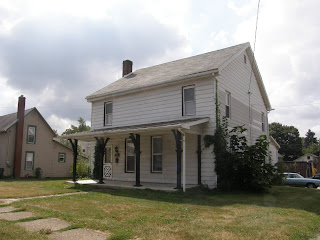 |
| Peter Bohart (1777-1825) |
In 1809, a German immigrant, moved from Washington County, Pennsylvania to a small cross road in the new state of Ohio. He soon built a two story log tavern at the cross roads of the Steubenville to Canton and New Lisbon to Cadiz pikes. In the following years he slowly acquired land and on October 4, 1815 he platted the village of Centerville, Ohio. His name was Peter Bohart.
Bohart’s dream of a town started with the profitability of the whiskey and distillery business in the “West.” He recognized that as a result of the proximity of the village two basic needs had to be met. First, since the nearest market was thirty miles away, over rough terrain and sometimes impassable roads, marred with dangers, a market had to be established to sell the local goods and products of the area. The second need was a tavern and lodging for the weary travelers along the pikes. Thus with his German grit and his sense of pioneering he went to work at meeting both needs for the area.
He first established his tavern with rooms upstairs for boarders, right at the intersection of the two pikes. It was a two story log structure built in 1809, from hand hewn logs from the old growth forest encasing the small cross road. He sold general goods in the front of house with the tavern located in the rear and lodging upstairs, and on the other half of the building (divided downstairs by a solid wall) he and his family kept their residence.
Out back behind the tavern was a spring that had a stream heading south originating from it. This spring was constantly visited by black bears to the point that it was declared the spring must run with honey, and from that point on the stream has been known as Honey Run. This also created quite the recreational point of interest for those traversing the roads of “America’s West,” as it became a sport to try and bag a black bear from all different points within the tavern.

Peter Bohart was born in 1777 to Philip Bohart and was a native of Oberallgau, Bayern, Germany. He came to America around 1795 and travelled by foot to the Canonsburg, Pennsylvania area. Here he opened a small tavern and within a year married Catherine Eberly. She was the daughter of Jacob H. and Anna (Shirk) Eberly from Lancaster, Pennsylvania and was born in 1776. After moving to Columbiana County, Ohio “The Gateway to the West” and establishing his tavern, Peter and Catherine started a family. They had three children Nancy (1812-1859), Jacob (1813-1890) and Delilah.
However, things were rough on the frontier and Peter’s marriage to Catherine had its trials. In the Ohio Patriot on July 20, 1822, Peter Bohart put the following in the paper: “Notice: whereas my wife Catharina has left my bed & board without any just cause or provocation, this is to forewarn any person or persons from harboring or trusting her on my account." It is not clear as to what all transpired before or after this because upon her death in 1857, she was laid to rest at Peter’s side. It should also be noted that after Peter’s death on April 25, 1825 at the age of 48, his neighbor Samuel Bushong was appointed guardian for Jacob and Delilah, who were both still minors.
Peter Bohart was an average man, for all intent and purposes, but he was truly more than that. He came to this new country searching for the American dream. He heard of promises of the west found in Pennsylvania, but soon made way to the untamed area of eastern Ohio. With his strong and defiant German stock leading him he carved out a piece of land that not only would be a place to call home for him and his family but for countless others that followed in the future generations. Although his life was rather short, the seeds of life that Peter Bohart planted would soon blossom under the care of others into a small and prosperous town. (Isaac Atkinson purchased all of Peter Bohart’s Estate in 1825 and soon built upon what was started. He allocated more land for the town, built mills, stores, and public places and on December 25, 1832 had the town of Carrollton incorporated as the new county seat of the newly formed Carroll County.)
 |
| Bohart's Tavern (Circa 1915) |
Furthermore, on July 5, 1838, General William Henry Harrison stayed the night after addressing the county’s Whig Party from the steps of the tavern. Harrison was brought to Carrollton from Massillon by stage coach where he had been campaigning the day before with a Glorious 4th address. General Harrison spent the next morning in town before heading to Steubenville.
 |
| Bohart's Tavern (2011) |
Eckley, H.J.; Perry, W.T. (1921). History of Carroll and Harrison Counties. The Lewis Publishing Co.
Free Press Standard (1915) Carrollton Centennial Souvenir Edition
Herald, Peter M. (1883) Early History of Carroll County
Howe, Henry (1907). Historical Collections of Ohio, The Ohio Centennial Edition.
The State of OhioVol I, p. 351
The Ohio Patriot (20 July 1822)
No comments:
Post a Comment
Note: Only a member of this blog may post a comment.